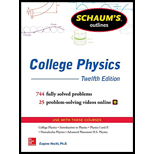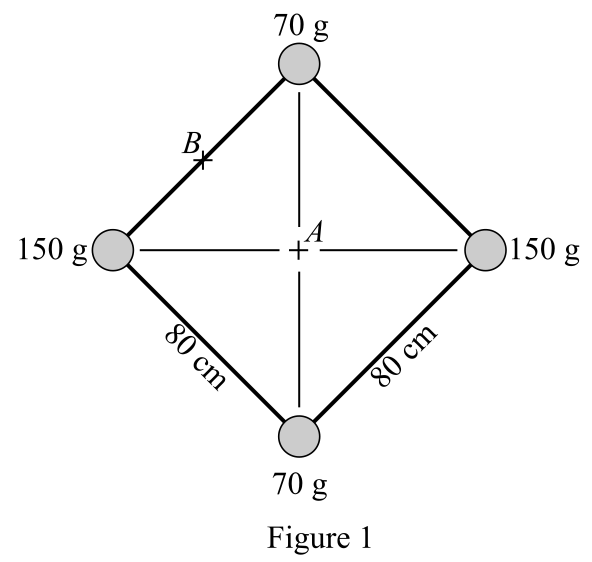
Concept explainers
Figure 10-13 shows four masses that are held at the corners of a square by a very light frame. What is the moment of inertia of the system about an axis perpendicular to the page (a) through A and (b) through B?
![Chapter 10, Problem 57SP, 10.57 [I] Figure 10-13 shows four masses that are held at the corners of a square by a very light](https://content.bartleby.com/tbms-images/9781259587399/Chapter-10/images/87399-10-57sp-question-digital_image59.png)
Fig. 10-13
(a)
The moment of inertia of the system shown in Fig. 10.13, about an axis perpendicular to the page through A.
Answer to Problem 57SP
Solution:
Explanation of Solution
Given data:
The system of four masses are shown as follows:

Formula used:
Write the expression of moment of inertia of a mass system about an axis is given as follows.
Here,
Write the expression of Pythagoras theorem in right angled triangle to find the distance of point mass from the axis.
Here,
Explanation:
Redraw the diagram of the system show provided in the question:

From fig. 1, infer that all the point masses are at equal distance from the axis perpendicular to page through A. Let the distance of point masses from the axis be
The expression of distance of point masses from axis perpendicular to page through A is,
Here,
Substitute
Solve for
The expression of moment of inertia about a given axisfor a mass system is as follows,
Since, the perpendicular distances of all the point masses from the given axis are equal, therefore, the expression of the distance of all point masses from the given axis is,
Substitute
Substitute
Conclusion:
The moment of inertia of the system about an axis perpendicular to the page through A is
(b)
The moment of inertia of the system shown in Fig. 10-13, about an axis perpendicular to the page through B.
Answer to Problem 57SP
Solution:
Explanation of Solution
Given data:
The system of four masses that are held at the corners of a square by a very light frame as shown in fig. 1.
Formula used:
Write the expression of moment of inertia about a given axis.
Here,
Write the expression of Pythagoras theorem in right angled triangle to find the distance of point mass from the axis.
Here,
Explanation:
From fig. 1, infer that the distance of point mass
The expression of distance of point mass,
Here,
Substitute
The expression of Pythagoras theorem in right angled triangle to find the distance of point mass from the axis B.
Here,
Substitute
Solve for
Further, solve the expression.
The expression of moment of inertia about a given axis is,
Substitute
Substitute
Conclusion:
The moment of inertia of the system about an axis perpendicular to the page through B is
Want to see more full solutions like this?
Chapter 10 Solutions
Schaum's Outline of College Physics, Twelfth Edition (Schaum's Outlines)
- Problem Eight. A snowmobile is originally at the point with position vector 31.1 m at 95.5° counterclockwise from the x-axis, moving with velocity 4.89 m/s at 40.0°. It moves with constant acceleration 1.73 m/s² at 200°. After 5.00 s have elapsed, find the following. 9.) The velocity vector in m/s. (A)=-4.38+0.185ĵ (D) = 0.185 +4.38ĵ (B)=0.1851-4.38ĵ (E) = 4.38 +0.185ĵ (C) v=-0.1851-4.38ĵ (A)=-39.3-4.30ĵ 10.) The final position vector in meters. (B)=39.3-4.30ĵ (C) = -4.61 +39.3ĵ (D) = 39.31 +4.30ĵ (E) = 4.30 +39.3ĵarrow_forwardProblem Seven. A football receiver running straight downfield at 5.60 m/s is 11.5 m in front of the quarterback when a pass is thrown downfield at an angle of 35.0° above the horizon. 8.) If the receiver never changes speed and the ball is caught at the same height from which it was thrown, find the distance between the quarterback and the receiver when the catch is made. (A) 21.3 (B) 17.8 (C) 18.8 (D) 19.9 (E) 67.5arrow_forward3 Consider a ball sliding down a ramp as shown above. The ball is already in motion at the position 1. Which direction best approximates the direction of instantaneous velocity vector V when the object is at position 3?arrow_forward
- No chatgpt plsarrow_forwardA car in a roller coaster moves along a track that consists of a sequence of ups and downs. Let the x axis be parallel to the ground and the positive y axis point upward. In the time interval from t 0 tot = = 4s, the trajectory of the car along a certain section of the track is given by 7 = A(1 m/s)ti + A [(1 m/s³) t³ - 6(1 m/s²)t²]ĵ where A is a positive dimensionless constant. At t car ascending or descending? = 2.0 S is the roller coaster Ascending. Descending.arrow_forwardneed help on first part its not 220arrow_forward
 University Physics Volume 1PhysicsISBN:9781938168277Author:William Moebs, Samuel J. Ling, Jeff SannyPublisher:OpenStax - Rice University
University Physics Volume 1PhysicsISBN:9781938168277Author:William Moebs, Samuel J. Ling, Jeff SannyPublisher:OpenStax - Rice University Physics for Scientists and Engineers: Foundations...PhysicsISBN:9781133939146Author:Katz, Debora M.Publisher:Cengage Learning
Physics for Scientists and Engineers: Foundations...PhysicsISBN:9781133939146Author:Katz, Debora M.Publisher:Cengage Learning Principles of Physics: A Calculus-Based TextPhysicsISBN:9781133104261Author:Raymond A. Serway, John W. JewettPublisher:Cengage Learning
Principles of Physics: A Calculus-Based TextPhysicsISBN:9781133104261Author:Raymond A. Serway, John W. JewettPublisher:Cengage Learning Glencoe Physics: Principles and Problems, Student...PhysicsISBN:9780078807213Author:Paul W. ZitzewitzPublisher:Glencoe/McGraw-Hill
Glencoe Physics: Principles and Problems, Student...PhysicsISBN:9780078807213Author:Paul W. ZitzewitzPublisher:Glencoe/McGraw-Hill Physics for Scientists and Engineers, Technology ...PhysicsISBN:9781305116399Author:Raymond A. Serway, John W. JewettPublisher:Cengage Learning
Physics for Scientists and Engineers, Technology ...PhysicsISBN:9781305116399Author:Raymond A. Serway, John W. JewettPublisher:Cengage Learning Classical Dynamics of Particles and SystemsPhysicsISBN:9780534408961Author:Stephen T. Thornton, Jerry B. MarionPublisher:Cengage Learning
Classical Dynamics of Particles and SystemsPhysicsISBN:9780534408961Author:Stephen T. Thornton, Jerry B. MarionPublisher:Cengage Learning





